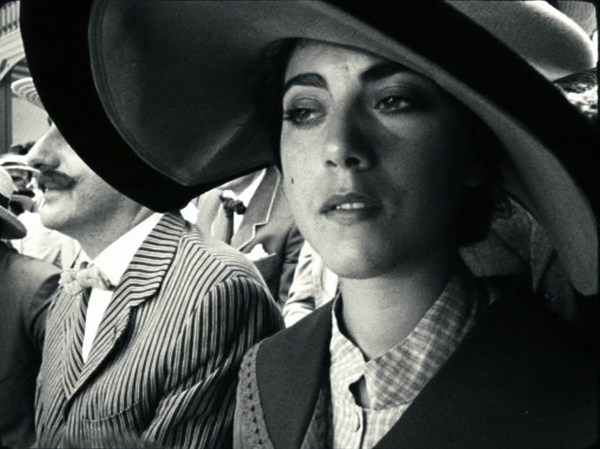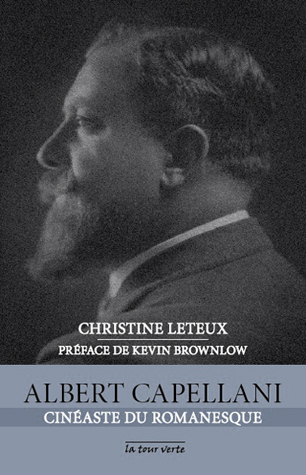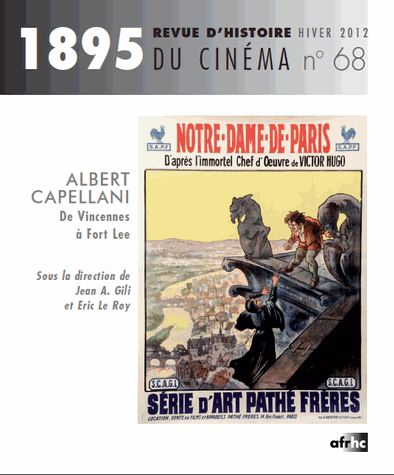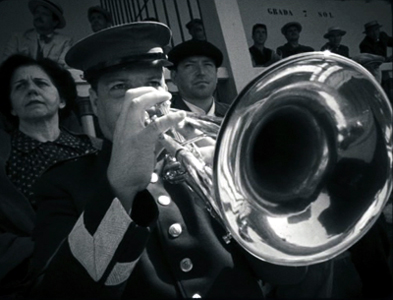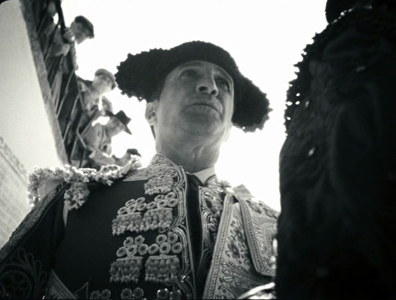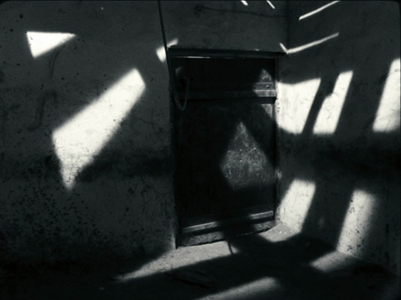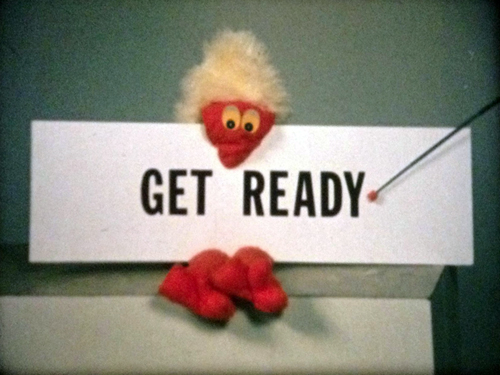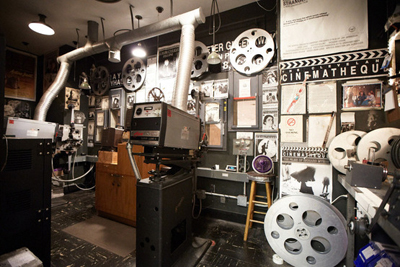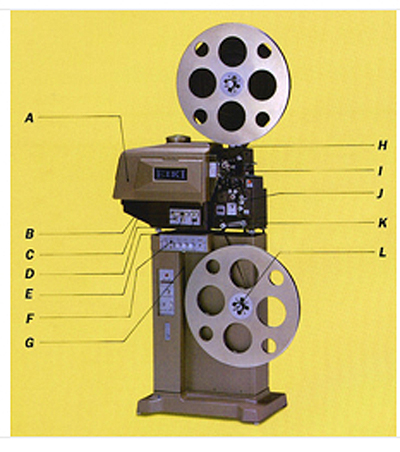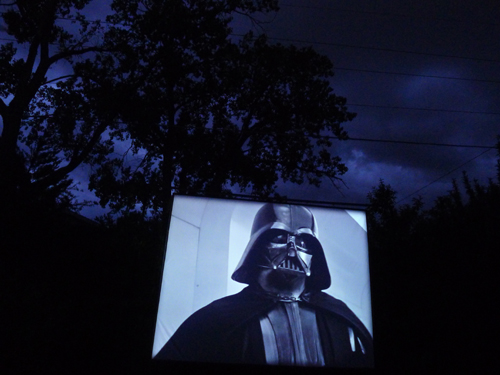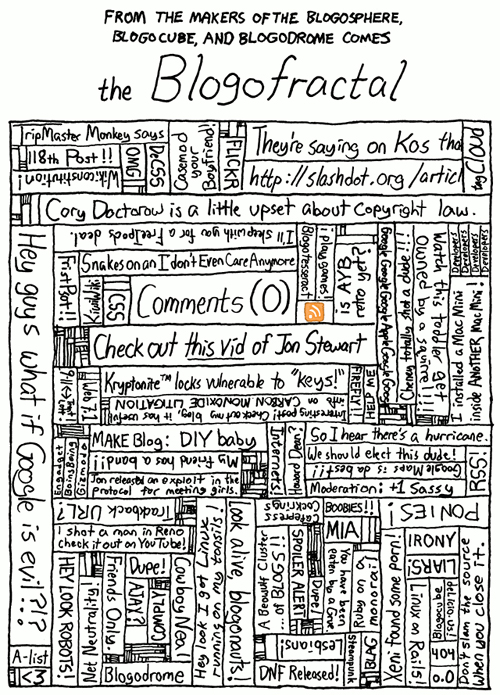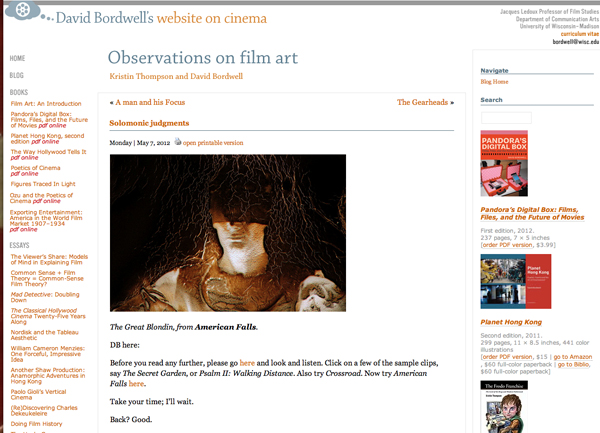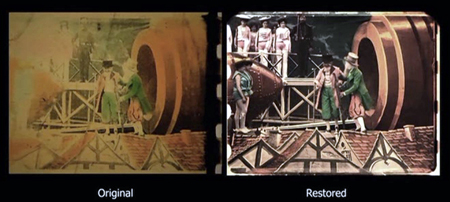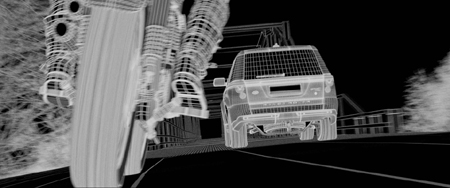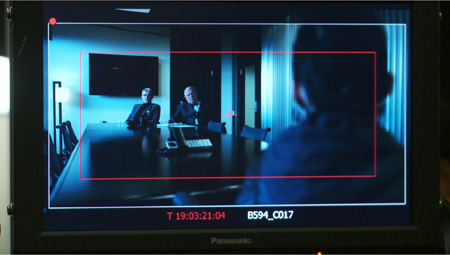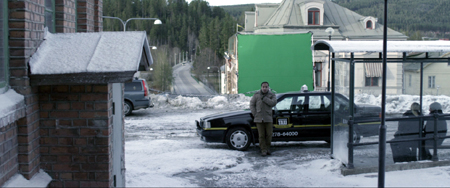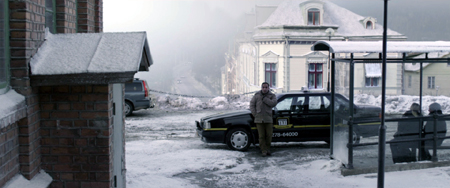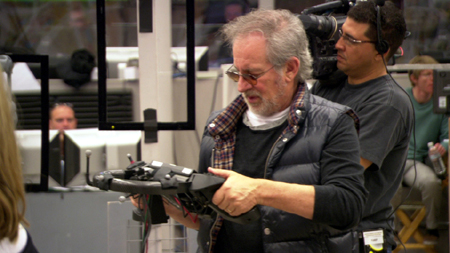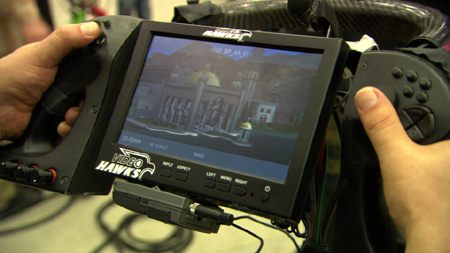Archive for the 'Film history' Category
Silent films, old and new
Blancanieves
Kristin here:
February and March have been good to silent cinema. Time for a round-up of some highlights as we impatiently anticipate Il Cinema Ritrovato, coming up in a little over two months.
Publications on Albert Capellani
In reporting on the 2010 and 2011 programs of Il Cinema Ritrovato, I highlighted one of the festival’s major revelations, that of the silent films of Albert Capellani. These generous doses of Capellani’s splendid films were put together by Mariann Lewinsky, who realized his importance after she included some of his shorts in her annual “Cento Anni Fa” programs. In my entries I argued that Capellani was revealed as one of the early cinema’s great masters. (The 2010 entry is here, and the 2011 one here.)
Not surprisingly, during the intervening years, scholars have been busy researching Capellani’s films and career. March 6 to 24 saw a major retrospective at the Cinémathèque Française. (Information on the program is still available online, as is a detailed press release.) Shortly before it began, the first biography appeared: Christine Leteux’s Albert Capellani: Cineaste du Romanesque, with a foreword by Kevin Brownlow.
Leteux discovered Capellani in May of 2012, thanks to seeing Notre-Dame de Paris and Les Misérables at the Forum des Images in Paris. Setting out to learn more about the filmmaker, she realized how thoroughly his memory had nearly vanished from film history. She sought out and received the cooperation of his grandson, Bernard Basset-Capellani, whom she describes as “intarissable” (inexhaustible) on the subject.
The result is a solid, traditional biography, with chapters mostly organized around the companies for which Capellani worked (Pathe, SCAGL, World, Mutual, and so on) and some of his key films (Les Misérables, The Red Lantern). The prose style is easily readable French, at least to someone like me with an average knowledge of the language. For an interview with Leteux concerning the book, see here.
The book is on sale at the Cinémathèque’s shop, which unfortunately does not sell online. It was supposed to be available on Amazon.fr, but so far is not. The easiest way for those outside France to order it is through three third-party book-sellers on amazon.fr, all offering it at the cover price of 14.90 €. Leteux’s book is a vital source for anyone interested in early cinema.
I was pleased to see that the last chapter ends with some quotations from my second entry on Capellani, ending with “With the end of the main retrospective, however, it is safe to say that from now on anyone who claims to know early film history will need to be familiar with Capellani’s work.”
The book includes a filmography and list of films available on DVD. These include a new one, a restoration of The Red Lantern by our friends at the Cinematek in Brussels, available on Amazon.fr or directly from the Cinematek’s shop.
The French-language historical journal on cinema, 1895, timed its March, 2013 issue to coincide with the Cinémathèque’s retrospective. It is entirely devoted to Capellani. I have not had a chance to see it yet, but the table of contents is available here. The only online purchasing source for individual issues I have found is here; the page gives a lengthy summary of the contents.
Mariann continues to search for more surviving prints for restoration and eventual inclusion in future editions of Il Cinema Ritrovato. She has sent me some tantalizing news about recent discoveries and restorations. There will be a third Capellani season in 2014. This will probably include some of the director’s American films: Social Hypocrites (now restored), Flash of the Emerald (the one surviving reel), Inside of the Cup (surviving but so far with no projection print), Eye for Eye (two surviving reals), Sisters, and the French film Le Nabab. Other possible restorations include House of Mirth, La belle limonadiere, and Oh Boy!
A description of the 2013 Ritrovato festival is available here.
Nanook and friends
Early this year we posted our annual list of the ten best films of ninety years ago. It featured the classic early documentary, Robert Flaherty’s Nanook of the North. In March our friends at Flicker Alley released a two-disc Blu-ray edition of Nanook paired with the 1934 Danish feature, The Wedding of Palo (Palos Brudefærd). The latter is one of those titles that one occasionally encounters on the fringes of older historical surveys, but it has been difficult indeed to see. This new print is a 2012 restoration from a George Eastman House original 35mm nitrate copy.
 Nanook is familiar enough, but The Wedding of Palo is not. It was made by the Danish explorer and anthropologist Knud Rasmussen, who appears in a brief introductory passage. Clearly he was influenced by Flaherty’s work. He combines a simple fictional narrative with documentary scenes of traditional Inuit life in eastern Greenland. The basic story involves the heroine Navarona, whose brothers are reluctant to lose their housekeeper by allowing her to marry. Two men of the tribe court her and come into violent jealous conflict. Interjected are sequences of a salmon hunt, a festival, a traditional song duel between the two rivals, and a polar-bear hunt. The staged dialogue scenes involve sound recording, with no subtitles but the occasional brief intertitle to translate.
Nanook is familiar enough, but The Wedding of Palo is not. It was made by the Danish explorer and anthropologist Knud Rasmussen, who appears in a brief introductory passage. Clearly he was influenced by Flaherty’s work. He combines a simple fictional narrative with documentary scenes of traditional Inuit life in eastern Greenland. The basic story involves the heroine Navarona, whose brothers are reluctant to lose their housekeeper by allowing her to marry. Two men of the tribe court her and come into violent jealous conflict. Interjected are sequences of a salmon hunt, a festival, a traditional song duel between the two rivals, and a polar-bear hunt. The staged dialogue scenes involve sound recording, with no subtitles but the occasional brief intertitle to translate.
As in Nanook, the non-professional actors are remarkably natural, especially the “actress” portraying the heroine. There is a cute young boy brought in at intervals for comic appeal, and the members of the village seem always to be laughing and enjoying a suspiciously carefree life. The film has the advantage of more spectacular scenery than that in Flaherty’s film, with huge mountains and glaciers in place of the vast ice-covered vistas (see bottom image).
As usual, the Flicker Alley team has gone beyond the call of duty with this release. It includes not only the two features, but six bonus films, as described in the press release:
Nanook Revisited (Saumialuk) by Claude Massot was made in the same locations used by Flaherty. It shows how Inuit life changed in the intervening decades, how Flaherty consciously depicted a culture which was then already vanishing, and how Nanook is used today to teach the Inuit their heritage. Nanook Revisited was produced in 1988 on standard definition video for French television. Dwellings of the Far North (1928) is the igloo-building sequence of Nanook re-edited and re-titled as an educational film; Arctic Hunt (1913) and extended excerpts from Primitive Love (1927) are by Arctic explorer Frank E. Kleinschmidt; Eskimo Hunters of Northwest Alaska (1949) by Louis deRochemont shows many activities seen in Nanook thirty years after, and Face of the High Arctic (1959) depicts the ecology of the region, produced by the National Film Board of Canada.
Altogether, the films run an impressive 281 minutes. There’s also a booklet with excerpts from Flaherty’s book, My Eskimo Friends, an essay by Lawrence Millman, “Knud Rasmussen and The Wedding of Palo,” and notes on the films.
Snow White and the Seven (?) Bullfighting Dwarves
In 2011, a French film, The Artist, gained huge attention in the infotainment media as a modern version of silent cinema, winning yet another Best Picture Oscar for the Weinstein brothers. It was a reasonably successful imitation of mid- to late 1920s cinema during the transition to sound. Now a much better modern silent film has arrived, Pablo Berger’s Blancanieves, a loose version of the Snow White story transposed to 1920s Spain. A famous bullfighter is paralyzed after being gored in the ring. His wife dies in childbirth and his scheming nurse marries him. She keeps his daughter, Carmen, away from her father by setting her to work as a downtrodden servant in his country estate. Upon her father’s death, the evil wife schemes to have her killed, and she escapes to the protection of a troupe of six bullfighting dwarves who, possessing uncertain arithmetic skills, bill themselves as seven bullfighting dwarves.
While The Artist was a fairly good imitation of 1920s Hollywood filmmaking, Blancanieves is a pastiche of the 1928-29 era of European silent cinema. It draws on what I have termed the International Style of filmmaking, a late 1920s blend of influences from the French Impressionism, German Expressionism, and Soviet Montage movements. One could almost pass it off as a genuine film of the era.
At times there are subjective effects à la Impressionism. A superimposition conveys Carmen’s memories of her father’s crucial instructions to her, and superimposed images of hands waving handkerchiefs present the enthusiam of the crowd’s plea for the bull to be pardoned.
This was also the period in which the power of the wide angle lens, particularly in close-ups and in low-angle shots, was exploited, initially in Soviet cinema and then all over Europe. Blancanieves is full of such shots, as in the frame at the top of this entry and in these two shots from the opening scene:
There are also montage sequences, building up to flurries of very short shots. This accelerated-editing technique is typical of both Soviet and French filmmaking of the era.
The too-frequent use of handheld camera in Blancanieves detracts somewhat from the feeling of authenticity. In the late 1920s, cameras were too heavy to be handheld. They could be strapped to the body of the cinematographer with harnesses, but that creates a subtly different look. And during the late 1920s, shots with the camera holding on a character while the background spins around behind him or her would have been achieved by placing both camera and actor on a large turntable. (This effect apparently was pioneered in Germany in the mid-1920s). But the occasional dramatic lighting effects, particularly in the climactic scene, are distinctly reminiscent of German cinema.
In general, the narrative is charming and amusing. The heroine’s pet rooster provides exactly the sort of comic relief that is common in films of the 1920s, and the story has an effective fairy-tale quality. I found the ending a bit disappointing and certainly not typical of the films of the 1920s. Still, Berger has clearly watched an enormous number of 1920s European films and absorbed their styles. He can imitate the International Style remarkably well, telling a tale that is appropriate to the 1920s and yet has a touch of humor that doesn’t belittle the silent era.
Blancanieves was released in the US on March 29 and is currently making the rounds of art-houses and festivals.
Other entries discussing the International Style and wide-angle filming at the end of the silent era can be found here and here.
The Wedding of Palo
16, still super
From Lost & Found Film Club.
DB back:
While I was semi-snowbound in Evanston, IL, messages kept rolling in. Many of them were responding to my account of surrendering my 16mm movies and gear. That post’s whiff of nostalgia was caught by Gary Meyer, co-director of the Telluride Film Festival.
Don’t get me started on 16mm memories. I started showing movies in 8mm at about ten years old and by thirteen I had two for changeovers on silent classics rented from Cooper Films in Chicago. For about $2 I got a full feature and short including postage. Using my parents’ record collection I could score the films. . . .
Graduated to 16mm in high school when a local church and the library each offered use of their projectors and I started collecting prints seriously. In college I got a job in the media center showing films, cleaning prints and projectors. When the department decided to buy Bell & Howell Auto-Shreds, they sold off the old projectors for $50. I knew each machine intimately and selected the quietest, gentlest RCA 400 which I still have in a booth in my basement. One of my favorite projectors.
With 16mm projectors I have shown movies on garage doors from my apartment, in a barn, an orchard or two, and most famously on clouds, which resulted in the police department getting many phone calls about aliens.
Gary reports that his former venue, the Balboa Theatre, has given its theatrical Eiki projector to the San Francisco State University film department, but it can be borrowed back if ever needed. A more acute sense of the passing of an era was reported by program curator and Czech arts consultant Irena Kovarova:
One of the sad moments in my film history was being invited to the Czech Embassy in Washington, DC to visit a room of 16mm film piles. I was asked to pick and choose which ones should be saved and which would be chucked away (the majority). It was a collection of films that the Embassy inherited from the Communist-era offices when the staff was shipped films for their entertainment (Czech popular comedies) and of course tons of “travel” and “propaganda” stuff. It was impossible to know what was really there and a lot was mediocre, but still such a sad thing that no one could really dig in and explore.
Secrets of the Incas, and non-Incas
Projection booth, Cleveland Cinematheque.
But there was good news too. In the course of that entry, I said that 16 was “nearly dead” as an exhibition format. Trust this blog’s alert readers to give a more upbeat emphasis and offer some weighty counterexamples. Don’t hesitate to use the hyperlinks!
I was confirmed in my belief that archives will keep the format going. I hear from our old friend Antti Alanen of the National Audiovisual Archive of Finland, that 16 flourishes in Helsinki.
We still keep screening 16mm regularly at Cinema Orion, and for the moment print access is still good. We recently showed three programs of Stan Brakhage movies (from Canyon Cinema) and one programme of Rose Lowder movies (from Light Cone of Paris), all in the original format of 16mm, all prints and colours perfect.
I haven’t seen Brakhage on DVD, but those who have remarked that it is not the same thing. There is something about the special sensuality of 16mm which is essential to the Stan Brakhage experience. All of those films fill up the senses.
Besides Canyon Cinema and Light Cone, LUX in London still seems to be well-stocked with good 16mm prints in commercial distribution.
Bracing news. Antti mentions as well that he used to be able to access 16mm films made for the Finnish Broadcasting Corporation, but now the agency has realized that the prints are irreplaceable and provide digibeta copies instead. The loss for showing is a gain for preservation.
I indicated as well that colleges, universities, and museums will probably maintain 16mm prints and showings. My correspondents have confirmed it, and offer some ripe local detail. Tracy Stephenson of the Museum of Fine Arts, Houston, tells me that they have shown films since the 1930s and may be the only venue in Houston that still screens 16. They have a program of jazz shorts coming up in June.
Here’s John Ewing of Cleveland:
I still show 16mm on occasion (and two-projector 16mm at that) at both of my venues: the Cleveland Cinematheque and the Cleveland Museum of Art. In fact, I just ran the 16mm program from the 50th Ann arbor Film Festival tour last Thursday night at the Cinematheque. Last time I showed 16 at the art museum was in December when we screened an IB Tech print of Secret of the Incas, from the Academy Film Archive.
From the Oklahoma City Museum of Art, Brian Hearn writes:
We are pretty serious about 16mm and maintain a modest collection of about 500 prints, ranging from Lumiere Brothers shorts to studio features to avant-garde to educational films to 70s exploitation trailers. As the film medium dematerializes it makes me appreciate our collection even more, vinegar and pink fading prints included!
Calling a collection of 500 titles modest makes me grin (in envy). On the university side, Jon Vickers supplies other breathtaking information:
Indiana University Cinema programs from the University’s 16mm collection on a regular basis, with 16mm screenings at least once each month. In the IU Libraries Film Archives, there are over 80,000 items, the majority being 16mm. Within that collection is Lilly Library’s David Bradley Collection, spanning the history of cinema in the US and Europe, including classic, obscure, and some unique titles. We dedicate a series each semester to the holdings within the Bradley Collection (programmed by Film and Media Studies grad students), as well as program from the educational/non-theatrical collections and holdings.
We can’t imagine a day when we will stop screening 16mm.
With that treasure house, I can see why! Pablo Kjolseth of the University of Colorado at Boulder also defends the format resolutely. Pablo has written one of the most fiery and persuasive polemics on digital cinema. Not only does his program have an extensive library, but they are still actively collecting in 16. Moreover, as home to the annual Brakhage Center for Media Arts symposium on experimental film (coming up next week), Boulder’s campus relies constantly on 16.
Hipsters, nostalgics, and toddlers
Eiki EX-9100 Professional 16mm Sound Optical/Magnetic projector with 2000-watt lamp. Currently available on eBay for $8,500.
Perhaps the most cheering news comes from those enterprising programmers of films for public venues, both for-profit and not-. Barak Epstein of the Texas Theater uses Kodak Pageants (of my fond memory) with manual changeovers and a manual audio fader. Pittsburgh Filmmmakers, writes Gary Kaboly, uses its Kinoton and Eiki machines every couple of months. He adds:
Throwing around the idea of a “classic 16mm experimental” series in the fall. Young Hipsters see attending a 16mm show as an “event.” Old Hipsters always describe what an Art House was “back in the day.”
The Cinefamily venue of LA has established itself as home to what the local paper called “pathologically idiosyncratic programming,” and 16 adds sharp spice to the mix. Here’s Hadrian Belove, the Head Programmer, on his personal quest and the formation of the Lost & Found Film Club:
I’m definitely of an age that would be post-16mm collecting, but still got hooked. One of the great appeals of 16mm for me is it feels like the final frontier for discovering true rarities. . . . It’s kind of the ultimate format for a “digger.” Finding Christian experimental films, industrial films, student films, and copies of TV movies, episodes, and even theatrical features that simply never made it to any form of video is de rigueur.
Nothing gives me more pleasure as an explorer than trolling eBay for 16mm.
I began showing things I would buy after hours to the staff here at Cinefamily, and hadn’t even considered it as a public show. Over time, some of the “kids” on the staff started buying their own 16mm ephemera, and finally proposed taking our private show public. I thought what the hell, cost is low, and we were doing it anyway. I gave them a terrible time slot I wasn’t using (10:30 on a Wednesday).
They launched this:
https://www.facebook.com/LostFoundFilmClub
Anyway, the first show had 100 people, even at 10:30 on a Wed night. Maybe it’s those grilled cheese sandwiches!
Finally, I had noted that FOOFs (Fans of Old Films) had a noble tradition of gathering in annual conventions. Jessica Rosner, film scout extraordinaire, writes of screenings at the upcoming Syracuse Cinefest: “The majority of films will STILL be in 16mm and they will be films that are rarely available to be seen any other way.”
A further note from Pablo Kjolseth brings things back to Gary Meyer’s childhood and the FOOF in us all. Pablo hosts summer screenings in his back yard.
My Eiki Xenon projector shoots through a guest-room window to the screen in the backyard – transforming the guest room into a “projection booth” of sorts. The next [picture] is a nice ominous shot of Darth under stormy skies. . . . Although I’ve played around with some digital screenings, everyone prefers the 16mm shows. And this even though I don’t do reel-changes or employ a take-up tower – thus having small intermissions between each reel change. These intermissions are quite popular, as it allows folks time to refill their drinks, go to the bathroom, and comment on what they’ve seen so far.
As many as 60 people might show up for any screening. As the children in the neighborhood are always entranced by the projector, I try to make sure to have a couple family-friendly screenings every summer. My neighbors are great: they’ve even tolerated backyard screenings of such titles as DAWN OF THE DEAD and THE TEXAS CHAIN SAW MASSACRE – admittedly poor choices, given that in the summer heat most people sleep with their windows open and late at night they might not appreciate all the screaming and, well, chainsaws. But, so far, no complaints!
None from my end, either. Is it just me, or does Darth look more menacing here than in any other setting?
After reading these communiqués, two thoughts. First, a great many programmers are working very hard to track down and screen unusual items for their audiences. These folks and their peers are committed to exploring cinema along routes that bypass the multiplex. Who wouldn’t rather watch Secret of the Incas than, say, The Last Exorcism Part II?
My second thought comes with a pang. Was I wise to clear out my 16 collection? Our department and other collectors benefit, but still… A basement will dry out, but films that are gone are gone.
Thanks to all who wrote me, and to the Art House Convergence list serve for its stimulating conversations.
Is there a blog in this class? 2012
From the xkcd webcomic
Kristin here:
August is here, and many film teachers are back from summer research trips and starting to prepare syllabi for the fall. Those who are using the new tenth edition of Film Art will have noticed that tucked away in its margins are references to blog entries relevant to the topics of each chapter. But since the new edition went to press, we’ve kept blogging. As has become our tradition, we offer an update on blogs from the past year that teachers might want to consult as they work on their lectures or assign their classes to read. Even if you’re not a teacher, perhaps you’d be interested in seeing some threads that tie together some recent entries.
For past entries in this series, see 2007, 2008, 2009, 2010, and 2011.
First, some general entries about the blog itself and the new edition of Film Art. On our blog’s fifth anniversary last year, we posted a brief historical overview of it. That entry contains some links to some of our most popular items. If you’re new to the blog and want some orientation, it could prove useful. Maybe students would be interested as well. At least the photos reveal our penchant for Polynesian adventure and shameless pursuit of celebrities.
In case you haven’t heard about the changes we made for the new Film Art, including our groundbreaking new partnership with the Criterion Collection to provide online examples with clips from classic movies, there’s a summary post available.
And here’s another entry on the new edition, discussing a new emphasis on filmmakers’ decisions and choices.
Now for chapter-by-chapter links.
Chapter 1
Understanding the movie business often means being skeptical of broad claims about supposed trends. We explained why the widespread “slump” of the movies in 2011 was no such thing in “One summer does not a slump make.”
Trying to keep one step ahead of students (or just keep up with them, period) on the conversion to digital projection and its many implications? Our series “Pandora’s Digital Box” explores many aspects:
In multiplexes: “Pandora’s digital box: In the multiplex”
In small-town theaters: “Pandora’s digital box: The last 35 picture show”
At film festivals: “Pandora’s digital box: At the festival”
On home video: “Pandora’s digital box: From the periphery to the center or the one of many centers”
In art-houses: “Pandora’s digital box: Art house, smart house”
Challenges to film archives: “Pandora’s digital box: Pix and pixels”
How projection is controlled from afar: “Pandora’s digital box: Notes on NOCs”
Problems introduced by digital: “Pandora’s digital box: From films to files”
Another case study of a small-town theater: “Pandora’s digital box: Harmony”
Or you can pay $3.99 and get the whole series, updated and with more information and illustrations, as a pdf file.
3D is a technological aspect of cinematography, but it’s also a business strategy. We explore how powerful forces within the industry used it as a stalking horse for digital projection in “It’s good to be the King of the World” and “The Gearheads.”
Independent films can be the basis for blockbuster franchises. “Indie” doesn’t always equal “small,” as we show in “Indie blockbuster franchise is not an oxymoron.”
One of the top American producers and screenwriters of independent films is James Schamus, head of Focus Features. We profile him in “A man and his focus.”
3D is probably here to stay, but it may have already passed its peak of popularity, as we suggest in “As the summer winds down, is 3D doing the same?”
The late Andrew Sarris played a crucial role in shaping the “auteur” theory of cinema. We talk about his work in “Octave’s hop.”
Chapter 2 The Significance of Film Form
“You are my density” is an analysis of motifs in Hollywood cinema, including a detailed look at a scene from Fritz Lang’s Hangmen Also Die.
Chapter 3 Narrative Form
We offer a narrative analysis of a Tinker Tailor Soldier Spy, a film many viewers found difficult to follow on first viewing, “TINKER TAILOR: A guide for the perplexed.” A follow-up, “TINKER TAILOR once more: Tradecraft,” concentrates on the adaptation of Le Carré’s novel.
A tricky narrative structure in Johnnie To’s Life without Principle called forth our entry, “Principle, with interest.”
In “John Ford and the Citizen Kane assumption,” we consider the possibility that Kane, analyzed in this chapter, might not be the greatest movie ever made.
Chapter 4 The Shot: Mise-en-scene
For some reason teachers (and apparently students) always want more, more, more on acting, the most difficult technique of mise-en-scene to pin down. “Hand jive” talks about hand gestures, which in the past were used a lot more than they are now. “Bette Davis eyelids” takes a close look at the subtleties of Bette Davis’ use of her eyes.
“You are my density,” already mentioned, offers several examples of dynamic staging in depth.
Chapter 8 Summary: Style as a Formal System
We have posted two entries dealing with form and style, specifically experimental artifice in 1940s Hollywood. These could be of interest to advanced students. “Puppetry and ventriloquism” deals in general with the topic, while “Play it again, Joan” looks at scenes that replay the same action or situation. The latter contains an analysis of a lengthy scene of Joan Crawford performing that could be useful in discussing staging and acting for Chapter 4.
Chapter 9 Film Genres
If you teach a unit on genre and choose to focus on mysteries, “I love a mystery: Extra-credit reading” gives some historical background information on the genre in popular literature and cinema.
Chapter 10 Documentary, Experimental, and Animated Films
“Solomonic judgments” centers on the gorgeous experimental films of Phil Solomon.
Chapter 11 Film Criticism: Sample Analyses
Our discussion of Tokyo Story in Film Art could be supplemented by this brief birthday tribute: “A modest extravagance: Four looks at Ozu.”
Chapter 12 Historical Change in Film Art: Conventions and Choices, Traditions and Trends
Last September I found an extraordinary little piece of formal and stylistic analysis using video, Variation: The Sunbeam, David W. Griffith, 1912. A Spanish film student, Aitor Gametxo, had displayed the staging and cutting patterns of Griffith’s Biograph short, The Sunbeam, by laying out the shots in a grid reflecting the actual spatial relations among the sets and running the action in real time. If you teach a history unit or just want an elegant, clear example of how editing of contiguous spaces works, this is a wonderful teaching tool. Classes may be particularly intrigued that a student was able to put together something this insightful. Plus The Sunbeam is a charming film that would probably appeal to students more than a lot of early cinema would. See “Variations on a Sunbeam: Exploring a Griffith Biograph film.” Gametxo’s film also provides an elegant example of how editing of adjacent spaces works and could be a useful teaching tool for Chapter 6.
Teachers showing a Georges Méliès film might have their students read “HUGO: Scorsese’s birthday present to George Méliès,” which has some background information on the career of this cinematic conjurer.
German silent film was the focus of “Not-quite-lost shadows.”
Not strictly on the blog, but alongside it, is a survey of how developments in film history generated changes in film theory. The essay is “The Viewer’s Share: Models of Mind in Explaining Film.”
Further general suggestions
Looking for some new and interesting films to add to your syllabus? We cover quite a few in our dispatches from the Vancouver International Film Festival 2011: “Reasons for cinephile optimism,” “Son of seduced by structure,” “Ponds and performers: Two experimental documentaries,” “Middle-Eastern crowd-pleasers in Vancouver,” and “More VIFF vitality, plain and fancy.”
Or if you seek information on historical films newly available on DVD, we occasionally post wrap-ups of recent releases, including a cornucopia of international silent films. See “Silents nights: DVD stocking-stuffers for those long winter evenings.”
We have also carried on our tradition of a year-end ten-best list—but of films from 90 years ago. Not all the films on our list for 1921 are on DVD, but most are: “The ten best films of … 1921.”
Every now and then we post an entry pointing to informative DVD supplements that might be useful teaching tools. It’s surprising how few of them go beyond a superficial level where the actors and filmmakers sit around praising each other: “Beyond praise 5: Still more supplements that really tell you something.”
Beyond praise 5: Still more supplements that really tell you something
Real-time performance-capture images for The Adventures of Tintin.
Kristin here:
The Extraordinary Voyage (2011, Serge Bromberg and Eric Lange)
I had expected to follow up my entry on Hugo when the DVD was released. I anticipated that its supplements would explore the flashy technical and artistic aspects in detail. But the lengthy first chapter proved to be largely the cast and crew presenting variations on how lucky they were to have worked with Martin Scorsese (and each other) and how much they learned from him.
That wasn’t promising, and I turned instead to Georges Méliès himself. Flicker Alley, which has served the filmmaker so well in the past (see here), has recently released the restored color version of A Trip to the Moon in a Blu-ray/DVD combination set. It is accompanied by a 65-minute documentary on the Méliès, the film, and the restoration. It’s odd to call a 65-minute film that accompanies a fifteen-minute “feature” a supplement, but I recommend it anyway.
I suspect that The Extraordinary Voyage would be quite effective in easing students into very early silent cinema and intriguing them about an era that must seem hopelessly remote to them. It begins with a charming introduction to the context of the turn of the previous century and then moves quickly into the director’s young-adult life. When it comes to the famous incident in which Méliès’ camera jammed while he was filming, creating an inadvertent magical transformation, the filmmakers have an actual 1937 recording of Méliès himself describing the event. Presumably this was the original source of this oft-repeated anecdote. He specifies that it happened on the Place de l’Opéra and involved a bus turning into a hearse. I still wonder if it all happened so neatly, but hearing it directly from Méliès makes it a little more plausible. If it wasn’t true, it should have been.
The film includes as talking heads several filmmakers who admire Méliès’ work: Costa-Gavras, Jean-Pierre Jeunet, Michael Gondry, Tom Hanks, and Michel Hazanavicius. There is a good summary of the fascination with the moon in popular culture of the day, 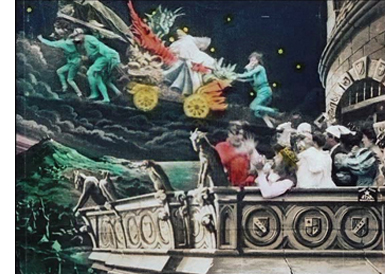 including works by Jules Verne, Jacques Offenbach, and H. G. Wells.
including works by Jules Verne, Jacques Offenbach, and H. G. Wells.
The documentary touches on issues relevant to early silent cinema in general. One of these is the frequent pirating of films, with Méliès starting an American branch of his Star Films in New York, under the direction of his brother Gaston, to help protect his intellectual property. A clip from the Segundo de Chomon version of the film, An Excursion to the Moon, is included.
At about 23 minutes in, a short overview of early movie music is given, followed by a helpful explanation of how the hand-coloring of Méliès’ films was handled by a local workshop run by women. At 30 minutes in there are several dazzling examples of hand-colored scenes (right).
After a quick summary of Méliès’ decline and death, the film moves to the restoration of the only known hand-colored copy of A Trip to the Moon, found in the film archive in Barcelona. Here the hero is Tom Burton, the Director of Technicolor Creative Services, who gives a brief indication of how computers have transformed restoration:
We have a palette of digital tools to work from that are a collection of maybe five or six of the main commercially available restoration platforms, but then we also bring into the mix all of the approaches that you would use if you were doing visual effects for a modern movie.
The comparison of visual effects with restoration is in some ways an apt one and might lead students to look upon early films in a new light.
The Girl with the Dragon Tattoo (Blu-ray/DVD/Ultraviolet set, Sony Pictures Home Entertainment)
It’s probably a good idea to supply both Blu-ray and DVD discs in one package, but including the supplements only in Blu-ray is annoying and increasingly common. That’s the way the Girl with the Dragon Tattoo discs have been handled. Teachers without access to a Blu-ray player have fewer options when trying to use supplements in teaching. It also makes it much more difficult to make frame grabs from the supplements to, say, illustrate a blog entry on useful supplements.
I decided to check out the supplements for this film because the ones for Zodiac and The Social Network were so good. I figured David Fincher was particularly concerned about his films’ bonus materials. Unfortunately this set of supplements is quite uneven. The cast and crew seem to be obsessed with the character of the heroine and with the delights of shooting in Sweden. I confess that I stopped watching some of the chapters as the talking heads went on and on about these subjects. Some of the tracks also consisted of a lot of candid behind-the-scenes footage, which is all very well, but there was little structure to this and only occasional comments to explain what was going on.
Fortunately the “Post-Production” section is very informative and interesting. “In the Cutting Room” is fairly technical but makes some fascinating points. I particularly liked the description of how Fincher eliminates reframings and unsteady shots by using the extra image space allowed by newer capture media. (Earlier digital film frames allowed no extra image area outside what would show up on the screen; as the image below indicates, the final frame can be selected from a larger picture.) This desire for a stable image in an era where the “queasi-cam” so often rules points to one distinctive trait in Fincher’s style. It indicates a willingness to actually think through the framing of each individual shot and the purpose for choosing that framing. Steven Spielberg does the same thing. Many don’t.
Editor Angus Wall talks about this advantage of the extra size of the image and how Fincher uses it to stabilize unsteady images. It’s worth quoting at length, and it demonstrates the thoughtful commentary in this particular supplement:
I’ve never seen a movie that was sort of “re-operated” to the extent that this one was. Which I think has an effect on the viewing of the movie. David is really type-A in terms of making the shots very specific. They start in a certain way, they end in a certain way. And the framing, he’s very precise in terms of his composition. He doesn’t like a lot of what you see in 99% of movies, which is very subtle moves where the operator will actually reframe according to how the actor’s moving. David doesn’t like that. Even if there were a lot of those in this film, and before, some of those takes we would have thrown out, because we just wouldn’t have been able to stabilize them to the degree that he likes it. With this, because you have this full raster, this big area around the image, you can take those images and stabilize them, really lock them down. So the movie is really locked down in terms of camera operating. More than any other movie that I can think of.
The smooth glide as the car initially approaches the country house is one example of that utter stability, used to ominous effect in that particular scene.
There’s also some interesting discussion about how the two main characters don’t meet each other until well into the film and how that affected decisions about editing. Rather than frequently intercutting between Mikael Blomkvist and Lisbeth Salander, the filmmakers decided to create longer self-contained scenes involving each, thus switching back and forth less frequently. The idea was that the exposition set forth in each scene would be too difficult to absorb if it was chopped into smaller segments. Form, style, and function, neatly explained.
Fincher also points to an interesting underlying anxiety the spectator might feel because the narrative progress gives little sense of how much action is still to come:
You don’t know where you are in the narrative. You don’t know if you’re at the beginning of the third act or … I don’t think it’s bad, because we have a five-act movie. I think that’s what’s causing everybody’s anxieties, that it doesn’t feel like, OK, here’s where we are, we’re entering the third act now. Now it feels like, fuck, this movie could go on … indefinitely. That’s the part that’s bothering me. If we told them it was going on for another forty-five minutes, they wouldn’t have a problem. It’s the indefinite part.
Since I’ve written a book claiming that classical films usually don’t have three acts, I was intrigued by this statement. (See also my earlier blog entry here and David’s essay here.) I posit instead that classical films typically create acts that run about 25 to 30 minutes, and that the film’s length determines how many acts it has. Four acts is the most common throughout Hollywood’s history, but a 158-minute film would be likely to have five acts. (Has David Fincher read my book?!) His point about the audience feeling a bit lost in an unconventional narrative structure is a rare instance of a director talking about form in such an abstract way, and it seems quite valid for The Girl with the Dragon Tattoo.
It’s also rare to get a supplement on ADR (automated [or additional] dialogue replacement), but there’s a six-minute one in the “Post-Production” section. This consists of a behind-the-scenes session with Rooney Mara supplying not just dialogue but breathing, grunts, and other noises. It’s clearly a real session, not a staged one, though the actress does seem a bit self-conscious with the documentarian’s camera turned on her. Fincher’s and Mara’s banter between takes gives a sense of what I suspect really goes on during this phase of production.
There’s a brief supplement called “Main Titles,” which deals with the form and inspiration for the CGI under the titles. Fincher wanted to tell the story of the whole trilogy in two and a half minutes, “and it has to be spectacular.” Apart from the discussion of form, there’s a good look at unrendered CGI footage compared to the finished images.
Finally, an eight-minute “Visual Effects Montage” displays a variety of special effects in a clever way. There is a section at the beginning where we are shown the image without added effects, then the same image with the areas to be altered highlighted in various superimposed colors, and finally the finished images with the effects added. This is particularly good for showing the sorts of mundane effects that are used to enhance shots unnoticeably, adding cars’ headlight beams, reflections in glass, falling snow, and the like. There is a shot with a section of a building on location blotted out with a greenscreen and the final shot showing the use of alterations in the building:
Obviously here the fog was also added with CGI.
This montage goes very quickly. If you’re using it in a class, best to prepare ahead and be ready to pause and point out what’s going on in the many short shots used in the demonstrations.
The second half of the effects montage moves to splashier scenes of the type the public associates with “special effects”: wire-frame vehicles for a chase (see image at the top of this section), head-replacement to add Mara’s head to her stunt-double’s body, and explosions.
Don’t bother with the “Stockholm Syndrome” section. Basically all we learn is that when a scene is shot on location, sheep can unexpectedly wander in and interfere.
The Adventures of Tintin (Blu-ray/DVD/Digital Copy combo, Paramount Pictures)
Again, the supplements for this release are available only in Blu-ray.
Steven Spielberg and Peter Jackson decided some years ago to collaborate on what was announced to be a three-film series adapted from Hergé’s Tintin comic books. The notion was that each of them would direct one film, with an as-yet-unspecified director doing the third. Spielberg’s initiatory film did not do as well at the domestic box-office as had been hoped, though it fared better in Europe and other non-North American markets, where the comics are highly popular. Jackson has announced that after he finishes both parts of The Hobbit, he will launch into the next Tintin film. (At least, that’s what he said originally. After yesterday’s announcement that there will be three Hobbit films, his start on the Tintin film will presumably be delayed.)
The supplements form a narrative of the film’s making, bookended by “Toasting Tintin” and “Toasting Tintin Part 2,” brief episodes set at the launch and wrap parties. The tale is pleasant and generally worth watching, though they are far from as entertaining and informative as the supplements that Michael Pellerin produced and directed for Jackson’s The Lord of the Rings and King Kong DVD sets. But this is Spielberg’s show, since he did the first film and indeed originated the project. At first he envisioned the film as live-action, with the dog Snowy the only major CGI character. Spielberg asked Jackson’s effects house Weta Digital to do some tests animating Snowy. To his (apparent) surprise, Jackson himself, as a fan of the comics since childhood, played Captain Haddock in the test. That fact was well known to fans, and the inclusion of the test footage (above) is no doubt a crowd-pleaser.
The decision to use cutting-edge performance-capture techniques led to the film being entirely animated.
“The World of Tintin” gives background on Hergé and deals briefly with the screenwriting process. This leads into “The Who’s Who of Tintin,” dealing with characters and acting, with some good material on performance capture near the end. The next section, “Tintin: Conceptual Design” has good material on the visual style of the characters and near the end includes some pre-viz material.
The outstanding supplement, however, is “Tintin: In the Volume,” nearly 18 minutes of footage concerning performance capture. Spielberg’s role as director was primarily concentrated into a remarkably short 31-day shoot with the actors. This was done in a state-of-the-art performance-capture facility called “The Volume” and located at Giant Studios. The Volume is a large space with about 160 cameras built into the ceiling and pointing down into the performance space. These capture the space from multiple angles. Additional cameras on the stage level follow the actors’ movements, which are inserted into the space. Moreover, hand-held monitors similar to portable gaming devices allow the filmmakers to see simple versions of the settings and the partially rendered characters while pointing the device at the actors in their performance-capture rigs.
There are also larger monitors that show the actors their own performances translated into the characters (top of entry). Whatever one thinks of the look of contemporary animation of this type, the technology has evolved to a remarkable level, and this supplement provides an excellent explanation of the practicalities of performance capture. We see the motion-capture suits being put on and the dots painted onto the actors’ skin. There is also information on how the set elements and props need to be transparent so that the cameras can capture the dots on the actors’ faces and costumes through them. The image at the bottom shows Jamie Bell as Tintin looking at a mock-up of the model ship. It’s made of little metal rods and rendered into a ship on the monitors.
“Snowy: From Beginning to End” is less cutesy than it sounds. It discussed the digital tool developed for modeling the dog’s fur. There’s also good stuff on how several dogs were recorded to provide different-sounding barks depending on the type of action in a scene.
The biggest tasks on the film came after the performance capture and editing. Weta Digital spent two years creating the final images. “Animating Tintin” is an excellent eleven-minute account of that process.
The sections “Tintin: The Score” and “Collecting Tintin” (on Weta Workshop’s designs for the collectible figures) are rather thin and could be skipped unless a teacher wants to show the whole set of supplements as a single “making-of” documentary.
It’s become apparent that many of the best supplements on Blu-ray and/or DVD releases are devoted to special effects, especially performance capture. The Adventures of Tintin does genuinely involve innovations in this technology, and the “In the Volume” chapter is very informative. Supplements are getting repetitive, though, and I would like to see the producers of such documentaries pay more attention to techniques and choices in other areas. Comparing final cuts of scenes with earlier cuts, or showing story conferences where real debates about scripts occur (as was done in the first Pirates of the Caribbean film’s supplements), or displaying how decisions about digital-intermediate grading are made–a bit of imagination could spice up the offerings. That and a realization that film fans are interested in just about any aspect of production (or distribution, for that matter). Supplements risk falling into conventional patterns, and that won’t make them the appealing bonus material that they used to be.
While I was gearing up to write this entry, we received Mark Parker and Deborah Parker’s book, The DVD and the Study of Film: The Attainable Text (Palgrave, 2011). Based on a great deal of research, including many interviews, the authors include a summary history of DVDs and supplements; there is a detailed chapter on The Criterion Collection, interviews with directors and scholars who have recorded commentary tracks, and a case study of Atom Egoyan.












